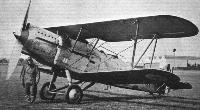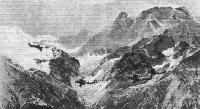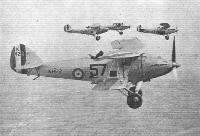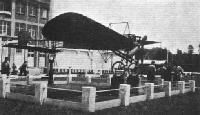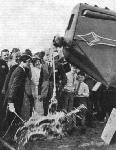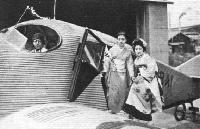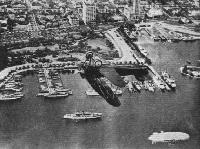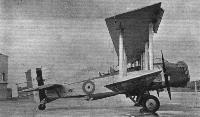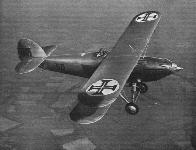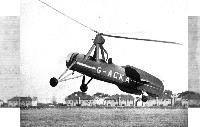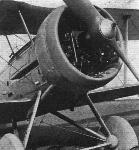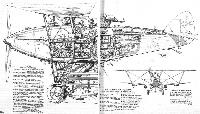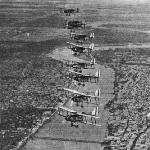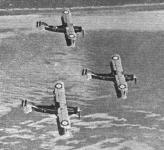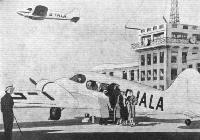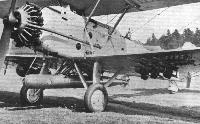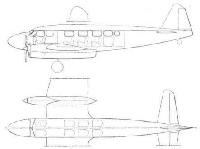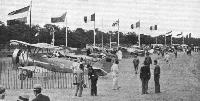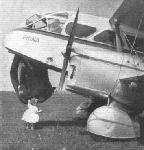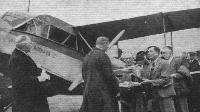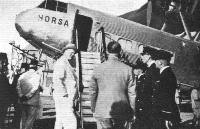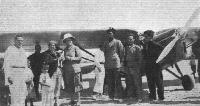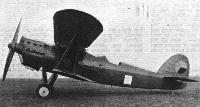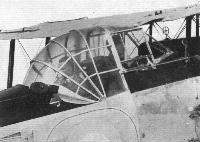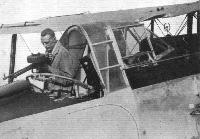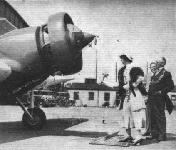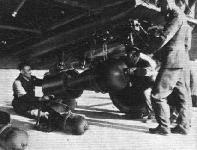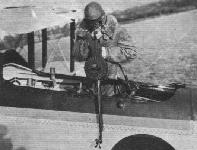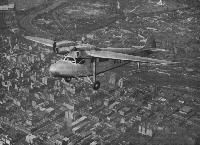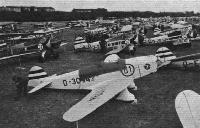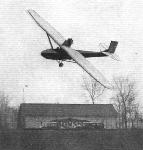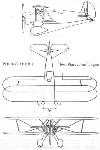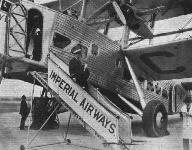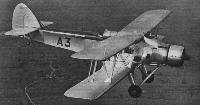Фотографии
-
Hawker "Hart" (Bristol "Pegasus" engine).
Самолёты на фотографии: Hawker Hart - Великобритания - 1928
-
Регистрационный номер: K2986 THE HENDON "AT HOME": Hawker "Harts" ("Kestrel") of No. 601 (County of London) (Bomber) Squadron, A.A.F., lined up at Hendon for the "At Home" held there last Sunday.
Самолёты на фотографии: Hawker Hart - Великобритания - 1928
-
INSTRUCTIONAL AIRCRAFT: This picture shows five types used at Cranwell for teaching cadets to fly. The leading machine is an Avro "Tutor," followed by a two-seater "Bulldog" and a single-seater "Bulldog," with an instructional "Hart" and a two-seater "Siskin" in the rear.
Самолёты на фотографии: Armstrong Whitworth Siskin - Великобритания - 1921Avro Tutor/Sea Tutor/Prefect / Type 621/646/626 - Великобритания - 1929Bristol Bulldog - Великобритания - 1927Hawker Hart - Великобритания - 1928
-
Регистрационный номер: K2434 Hawker "Hart" (Napier "Dagger" engine).
Самолёты на фотографии: Hawker Hart - Великобритания - 1928
-
INDIA: Nos. 11 and 39 (Bomber) Squadrons &i No. 2 (Indian) Wing from Risalpur regularly fly their "Harts" over the high passes of the Himalayas. They have absolute confidence in their "Kestrel" engines.
Самолёты на фотографии: Hawker Hart - Великобритания - 1928
-
Регистрационный номер: K1422 PRACTICE: The Hawker "Harts" of No. 57 in squadron formation on the occasion of the A.A.F. "At Home" last Sunday.
Самолёты на фотографии: Hawker Hart - Великобритания - 1928
-
1909-1934: The Bleriot monoplane (25-h.p. Anzani 3-cyl. air-cooled "fan-type" engine) on which M. Bleriot flew the Channel on July 25, 1909, on view at Buc Aerodrome last Saturday.
Самолёты на фотографии: Bleriot Bleriot-XI - Франция - 1909
-
1909-1934: M. Laurent Eynac - usually, but not at present, French Air Minister - Lord Londonderry, and M. Louis Bleriot beneath the latter's historic machine at Buc.
Самолёты на фотографии: Bleriot Bleriot-XI - Франция - 1909
-
ZONK! Ruddy Duck was the name given to the first Phillips & Powis School "Hawk" at Reading by Mrs. Miles last Saturday.
Самолёты на фотографии: Miles Hawk / M.2 - Великобритания - 1932
-
VARIETY AT VINCENNES: G. L. Harrison (centre) and Stephen Cliff (right) who flew the Miles "Hawk" from Heston; with them is R. A. C. Brie, who came over on the Autogiro.
Самолёты на фотографии: Miles Hawk / M.2 - Великобритания - 1932
-
"Bulldogs" ("Jupiter") of No. 19 (Fighter) Squadron
Самолёты на фотографии: Bristol Bulldog - Великобритания - 1927
-
Bristol "Bulldog IV" (Bristol "Perseus" sleeve valve engine).
Самолёты на фотографии: Bristol Bulldog - Великобритания - 1927
-
EAST IS WEST: Joyriding is now very popular with Japanese girls. Here are two "Geishas" about to make a flight in a Junkers F.13 operated by Japan Air Transport Institution at Ohama, Sakai, near Osaka.
Самолёты на фотографии: Junkers F 13 - Германия - 1919
-
Регистрационный номер: K2890 Vickers-Supermarine "Spitfire" (Rolls-Royce "Goshawk" engine).
Самолёты на фотографии: Supermarine Type 224 - Великобритания - 1931
-
AMERICA'S FLEET FIGHTER: The Boeing F4B-4 with supercharged Pratt and Whitney "Wasp."
Самолёты на фотографии: Boeing F4B / P-12 - США - 1928
-
Регистрационный номер: K3574 Short R.24/31 (two Rolls-Royce "Goshawk").
Popularly known as the “Knuckleduster” the flying boat shown was fitted with two Rolls-Royce Goshawk steam-cooled engines.Самолёты на фотографии: Short Knuckleduster / S.18 - Великобритания - 1933
-
Handley Page "Heyford" (two "Kestrel" III.MS).
Самолёты на фотографии: Handley Page Heyford / H.P.38 / H.P.50 - Великобритания - 1930
-
Handley Page "Heyford," Mark II (two Rolls-Royce "Kestrel" engines).
Самолёты на фотографии: Handley Page Heyford / H.P.38 / H.P.50 - Великобритания - 1930
-
[WACO ATO] LOOKING UP THE FUNNELS: An American pilot, Len Povey, flying, his special aerobatic machine on its back over Miami.
Самолёты на фотографии: WACO 10 / O Series - США - 1927
-
Регистрационный номер: J9186 J9186 modified to become the Overstrand I, with fully enclosed power-operated turret, enclosed pilot’s cockpit and windshield added to the rear dorsal gun position.
Самолёты на фотографии: Boulton Paul Overstrand / P.75 - Великобритания - 1933
-
Регистрационный номер: K3586 GETTING UPSTAIRS: Rapid climb is a first consideration in an interceptor fighter. The Hawker "Highspeed Fury" is seen here on its way upwards. The engine is a steam-cooled Rolls-Royce "Goshawk" 12-cyl. Vee type. This machine will be seen in public for the first time at the R.A.F. Display at Hendon next Saturday.
Самолёты на фотографии: Hawker Fury - Великобритания - 1931
-
FAST FIGHTERS FOR PORTUGAL: One of a batch of Hawker "Furies" (R.R. "Kestrel") which have been purchased by the Portuguese Government.
Самолёты на фотографии: Hawker Fury - Великобритания - 1931
-
"Furies" ("Kestrel") of No. 43 (Fighter) Squadron.
Самолёты на фотографии: Hawker Fury - Великобритания - 1931
-
Регистрационный номер: K4230 Cierva "Autogiro" (Armstrong-Siddeley "Civet" engine).
Самолёты на фотографии: Cierva/Avro C.30A / Rota - Великобритания - 1932
-
Регистрационный номер: G-ACKA ALLEZ OOP! The new C.30 P Autogiro leaps off the ground almost like a circus horse, and no doubt the extra power of the 7-cylinder "Genet Major" engine has a lot to do with this. Mr. H. A. Marsh, test pilot to the Autogiro Co., is an adept at demonstration, and in this case showed conclusively that this latest Autogiro has a far better take-off than the majority of other aircraft. Access to the passengers' cockpit is much better in this model, the side of the fuselage by the front cockpit having been made like a roll-top desk so that it can readily be lowered.
Самолёты на фотографии: Cierva/Avro C.30A / Rota - Великобритания - 1932
-
Самолёты на фотографии: Gloster Gauntlet - Великобритания - 1929
-
Самолёты на фотографии: Hawker Hardy - Великобритания - 1934
-
IN IRAQ: No. 55 (Bomber) Squadron fly their "Wapitis" ("Jupiter") in "echelon, stepped up" across the River Tigris at Baghdad.
Самолёты на фотографии: Westland Wapiti - Великобритания - 1927
-
Blackburn T.S.R. (Armstrong-Siddeley "Tiger" engine).
Самолёты на фотографии: Blackburn Shark / B-6 - Великобритания - 1933
-
"Gordon" ("Panther") day bombers of No. 35 (Bomber) Squadron.
Самолёты на фотографии: Fairey Gordon / Seal - Великобритания - 1931
-
Saro "Monospar Cloud" (two Armstrong-Siddeley "Serval" engines).
Самолёты на фотографии: Saunders-Roe Cloud / A.19 - Великобритания - 1930
-
Регистрационный номер: K3560 Saro R.24/31 (two Bristol "Pegasus" III).
Самолёты на фотографии: Saunders-Roe London / A.27 - Великобритания - 1934
-
A FAST AMPHIBIAN: The Grumman XJF-1 two-seater for the U.S. Navy.
Самолёты на фотографии: Grumman JF / J2F Duck - США - 1933
-
THE IMMEDIATE FUTURE: An artist's conception of the Avro 652 (two "Cheetah") briefly described in "Flight" last week. Two machines of this type have been ordered by Imperial Airways. The Caudron monoplane described above is in the same class, and a comparison between the two machines is interesting. The French example has considerably lower power than the Avro, is claimed to be faster and to land more slowly. Both types carry six passengers.
Самолёты на фотографии: Avro Anson / Type 652 - Великобритания - 1935
-
"MILITARY LOAD" - AND MORE. An 18-in. torpedo and an assortment of bombs on a Vickers "Vildebeest" torpedo bomber. Bombs and torpedo are alternative loadings. It is not possible to carry both at the same time.
Самолёты на фотографии: Vickers Vildebeest / Type 132 - Великобритания - 1928
-
Самолёты на фотографии: Caudron C.440 / C.445M Goeland - Франция - 1935
-
Регистрационный номер: D-UDAS A SPEEDY VISITOR: The Heinkel H.E.70A (630-h.p. B.M.W.) which gave demonstration flights at Croydon on Monday. It has a top speed of 230 m.p.h. and a cruising speed of about 200 m.p.h. The wheels fold outwards, into the wings.
Самолёты на фотографии: Heinkel He-70/Не-170 Blitz - Германия - 1932
-
Регистрационный номер: K2508 Avro "Tutor" (Siddeley "Lynx" IV C).
Самолёты на фотографии: Avro Tutor/Sea Tutor/Prefect / Type 621/646/626 - Великобритания - 1929
-
COULD PEGOUD HAVE FORESEEN THIS? Before he made the first loop, it is said that the French pilot Pegoud had himself strapped upside down to a bench to grow accustomed to the sensation. These instructors of the Central Flying School at Wittering seem quite at home in their inverted Avro "Tutors," in which they will perform at the R.A.F. Display.
Самолёты на фотографии: Avro Tutor/Sea Tutor/Prefect / Type 621/646/626 - Великобритания - 1929
-
AN INTERNATIONAL GATHERING: A view along the machine park at Vincennes. The Avro "Tutor" of the ill-fated Portuguese competitor is in the foreground.
Самолёты на фотографии: Avro Tutor/Sea Tutor/Prefect / Type 621/646/626 - Великобритания - 1929
-
"Demon" ("Kestrel") two-seater fighters of No. 23 (Fighter) Squadron.
Самолёты на фотографии: Hawker Demon - Великобритания - 1932
-
A BUSH AERODROME: Native interest in a "Gull" on Bathurst Is., N. Australia. The aerodrome was constructed under the supervision of Mr. F. X. Grell for use of any who may make the Timor Sea crossing and are in need of a "port of call."
Самолёты на фотографии: Percival Gull - Великобритания - 1932
-
BUILT FOR THE JOB: The Breda 28 "aerobatic" machine.
Самолёты на фотографии: Breda Ba.19 / Ba.25 / Ba.28 - Италия - 1930
-
Регистрационный номер: PH-AJX Built specially for the "feeder-line" services of K.L.M., the Koolhoven F.K.48 monoplane shown here may be fitted with two "Gipsy Major" or "Hermes IV" engines. Four different cabin layouts are available: for "feeder-line" work, air taxi service, joyriding, or for the carriage of freight or mail. In its "feeder-line" form, the machine carries pilot, wireless operator, six passengers and luggage at a cruising speed of 118 m.p.h. For an aircraft of only 260 h.p. this is a very creditable performance.
Самолёты на фотографии: Koolhoven FK-48 - Нидерланды - 1934
-
BAPTISMAL: Miss Fiona Mackinnon, aged thirteen months, christens her father's new "Dragon" at Penhurst Aerodrome. The machine is equipped with Marconi directional wireless.
Самолёты на фотографии: De Havilland Dragon / D.H.84 - Великобритания - 1932
-
ANOTHER AIR MAIL PENNANT: A new air mail service between Inverness and Kirkwall, Orkney, was inaugurated on Tuesday of last week (May 29) at Londman Aerodrome, Inverness, when the Royal Ait Mail Pennant was presented by Sir Frederick Williamson, Director of Postal Services, to Capt. Fresson, of Highland Airways.
Самолёты на фотографии: De Havilland Dragon / D.H.84 - Великобритания - 1932
-
Регистрационный номер: G-AAUC THE PENNANT IN EGYPT: Sir Miles Lampson, High Commissioner at Cairo, inspects the crew of the Imperial Airways airliner Horsa, after presenting the Royal Air Mail Pennant. Later he went up for a flight over Cairo.
Самолёты на фотографии: Handley Page H.P.42 / H.P.45 - Великобритания - 1930
-
Регистрационный номер: G-ACRG FAST COMFORT: Retractable undercarriage, highly tapered wings and clean lines, especially over the pilot's cockpit, are some of the many features which give the new British Klemm "Eagle" ("Gipsy Major") its fine performance.
Самолёты на фотографии: British Klemm BK-1 Eagle - Великобритания - 1934
-
AT VILLA CISNEROS: The Duchess of Bedford with the Governor of Rio di Oro and his family.
Самолёты на фотографии: De Havilland Puss Moth / D.H.80 - Великобритания - 1929
-
IN THE CANARIES: Parking out at the airport on the Grand Canary. Note the hangar in course of construction.
Самолёты на фотографии: De Havilland Puss Moth / D.H.80 - Великобритания - 1929
-
Регистрационный номер: K3615 Hawker "Osprey" (Rolls-Royce "Kestrel" II M.S.).
Самолёты на фотографии: Hawker Osprey - Великобритания - 1930
-
CZECHOSLOVAKIAN: The Aero 100, which has been designed lor general purpose work, has a top speed of 162 m.p.h.
Самолёты на фотографии: Aero A.100 / A.101 - Чехословакия - 1934
-
CRUSTACEAN: The new Westland scheme of cockpit protection applied to a "Wallace."
Самолёты на фотографии: Westland Wallace / PV.3 / PV.6 - Великобритания - 1931
-
CLEARED FOR ACTION: The gunner has folded away his enclosure in order to use his Lewis gun freely.
Самолёты на фотографии: Westland Wallace / PV.3 / PV.6 - Великобритания - 1931
-
Westland "Wallace" (Bristol "Pegasus" IM.3).
Самолёты на фотографии: Westland Wallace / PV.3 / PV.6 - Великобритания - 1931
-
Westland P.V.3 Everest machine (Bristol "Pegasus" engine).
Самолёты на фотографии: Westland Wallace / PV.3 / PV.6 - Великобритания - 1931
-
A LINK WITH THE SOUTH: Southern & Central Air Lines and London, Scottish & Provincial Airways are operating a connecting service between Southampton and Hull. The Mayoress of Southampton, Mrs. W. D. Buck, is here seen christening one of the Airspeed "Couriers," employed on this service, City of Southampton, at the Municipal Airport of Southampton.
Самолёты на фотографии: Airspeed Courier / AS.5 - Великобритания - 1933
-
Регистрационный номер: G-ACNZ THE RAPIER "COURIER": Air Vice-Marshal A. E. Borton, Director of D. Napier & Son, Ltd., has had one of his company's "Rapier" engines fitted to this Airspeed "Courier," and has entered the combination in the King's Cup race. A high performance is expected.
Самолёты на фотографии: Airspeed Courier / AS.5 - Великобритания - 1933
-
TROOP TRANSPORT OVERSEAS: The "Victoria" (two "Lions") carries 25 soldiers and their equipment. It is used by Nos. 216 (Bomber-Transport) Squadron at Heliopolis, Egypt, and No. 70 (B-T) Squadron at Hinaidi, Iraq.
Самолёты на фотографии: Vickers Victoria - Великобритания - 1922
-
THE FORD FREIGHTER: The Tri-motor Ford which, in conveying machinery, etc., to the mines 12,000 ft. up, has to clear part of the Andes into the bargain!
Самолёты на фотографии: Ford Tri-Motor / 4-AT / 5-AT - США - 1926
-
Blackburn "Perth" (three Rolls-Royce "Buzzard" II.MS) with a 37 mm. shell-gun. Note the flare of the vee bottom towards the bows.
Самолёты на фотографии: Blackburn Perth / R.B.3 - Великобритания - 1933
-
FOR ENGLAND-AUSTRALIA RACE: The Bleriot 111 monoplane fitted, it is believed, with a Gnome-Rhone K.14 ("Mistral") engine, entered for the MacRobertson England-Australia Race.
Самолёты на фотографии: Bleriot Bleriot-111 - Франция - 1929
-
"BOMBING UP." Fitting a heavy bomb to a rack beneath the wing of a Vickers "Virginia" night bomber.
Самолёты на фотографии: Vickers Virginia - Великобритания - 1922
-
FOR HIGH-SPEED GUNNERY. Firing vertically downward with a Lewis gun on a Fairey "High-Speed" mounting.
Самолёты на фотографии: Fairey Fairey IIIF - Великобритания - 1926
-
Fairey General Purpose aircraft (Armstrong-Siddeley "Tiger" engine).
Самолёты на фотографии: Fairey G.4/31 - Великобритания - 1934
-
AUSTRALIAN-BUILT: The "Codock" monoplane (Napier "Javelin" engines) flying over Melbourne.
Самолёты на фотографии: Cockatoo Dockyard & Engineering Co LJW-6 Codock - Австралия - 1933
-
Регистрационный номер: D-3094 DEUTSCHLANDFLUG, 1934: Some of the machines in the German tour at Tempelhof. The new Fieseler monoplane can be seen in the foreground.
Самолёты на фотографии: Fieseler F-4 / F-5 - Германия - 1933
-
Регистрационный номер: PH-AIZ OLD AND NEW: The Fokker F.XX (three Wright "Cyclones") with retractable undercarriage, and the standard F.XII (three P. & W. "Wasps"), on the tarmac at Croydon. The cruising speed of the F.XX is 157 m.p.h.
Самолёты на фотографии: Fokker F.IX / F.XII / F.XVIII - Нидерланды - 1929Fokker F.XX - Нидерланды - 1933
-
POBJOY "NIAGARA" ENGINES FLYING: Mr. C. Gardner has had two of the Pobjoy "Niagara" engines put in his Monospar, and is now carrying out test flights for the makers.
Самолёты на фотографии: General Aircraft Monospar ST-4 - ST-12 - Великобритания - 1932
-
VARIETY AT VINCENNES: The illustration shows the Junkers "Junior" flown by Capt. Placedo Abreu, of Portugal.
Самолёты на фотографии: Junkers A 50 Junior - Германия - 1929
-
The Belgian B.A.C. "Drone" on a sharp turn.
Самолёты на фотографии: Kronfeld Drone - Великобритания - 1932
-
EXPERIMENTAL: The Boeing XF6B-1 single-seater fighter ("Twin Wasp Jnr.") developed from the F4B-4.
Самолёты на фотографии: Boeing F6B - США - 1933
-
Регистрационный номер: S1589 Short R6/28 (six R.R. "Buzzard")
Самолёты на фотографии: Short Sarafand / S.14 - Великобритания - 1932
-
LOOKING DOWN: Visiting machines can be seen parked around the edge of the aerodrome, while in the foreground is the large Vickers "Vellox."
Самолёты на фотографии: Vickers Vellore / Vellox - Великобритания - 1928
-
Westland P.V.7 General Purpose machine (Bristol "Pegasus" engine).
The P.V.7 from which Penrose took to his parachute after the collapse of the port wing during a test flight.Самолёты на фотографии: Westland PV.7 - Великобритания - 1933
-
LIFE IN THE OLD DOG YET: Hans Grade flying his 25-year-old Grade monoplane during the "Flying Day" celebrations in Berlin.
Самолёты на фотографии: Grade monoplane - Германия - 1909
-
"PIECE FOR POLLY." The "piece," in this case, being a Lewis gun in the "parrot-cage," or revolving turret, on the Bristol 120.
Самолёты на фотографии: Bristol Bristol 118 / 120 - Великобритания - 1931
-
Самолёты на фотографии: Supermarine Scapa - Великобритания - 1932
-
DROPPING THE PILOT: Capt. A. B. H. Youell leaves the good ship Scylla via the new pilot's gangway.
Самолёты на фотографии: Short Scylla / L.17 - Великобритания - 1934
-
VARIETY AT VINCENNES: The record-breaking Caudron "Rafale" low-wing monoplane
Самолёты на фотографии: Caudron C.430 Rafale - Франция - 1934
-
Самолёты на фотографии: Walraven W-1 (Pattist-Walraven PW-1) - Индонезия - 1933
-
Регистрационный номер: K2891 Westland Day and Night Fighter (Rolls-Royce "Goshawk" engine).
Самолёты на фотографии: Westland PV.4 / F.7/30 - Великобритания - 1934
-
Armstrong-Whitworth A.W.19 (Armstrong-Siddeley "Tiger" engine).
Самолёты на фотографии: Armstrong Whitworth A.W.19 - Великобритания - 1934
-
Hawker Day and Night Fighter (Rolls-Royce "Goshawk" engine).
Самолёты на фотографии: Hawker PV.3 - Великобритания - 1934
Статьи
- Flight



